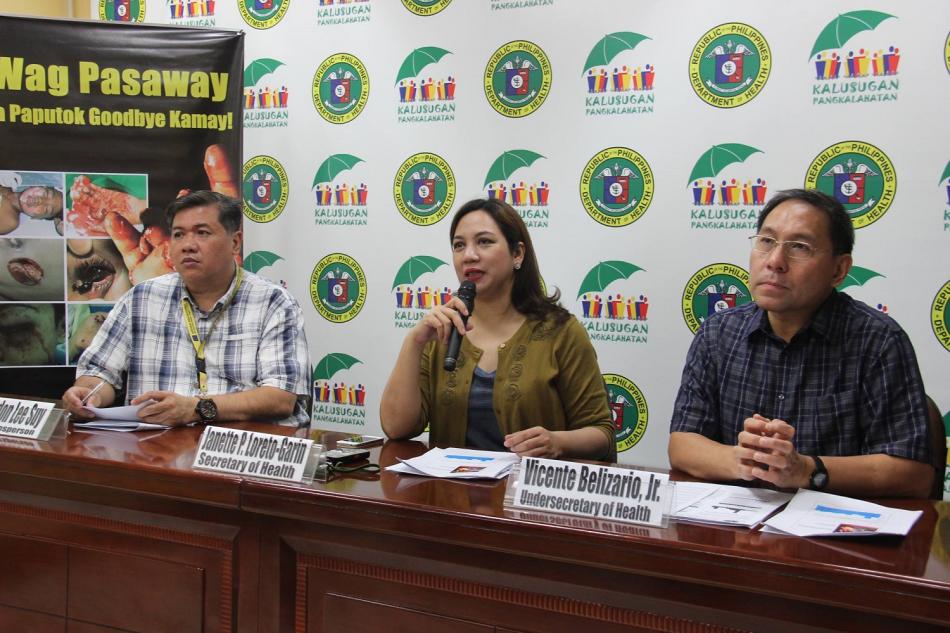
MANILA, Jan. 3—The number of fireworks-related injuries (FWRIs) reached 760 as the 15-day monitoring and surveillance by the Department of Health-Epidemiology Bureau (DOH-EB) entered its 13th day on Sunday, Jan. 3, 2016.
In a report submitted by DOH-EB Director IV Dr. Irma Asuncion based on the “Aksyon: Paputok Injury Reduction (APIR) 2015” campaign, she said that the total number of FWRIs was lower by 18 percent or 168 cases compared with the five-year average from 2010-2014 for the same period.
Also in comparison with the 839 cases recorded for the same period last year, the FWRIs from Dec. 21, 2015 to Jan. 3, 2016 were lower by 79 cases or nine percent, Dr. Asuncion said.
“Majority of the cases or a total of 427 equivalent to 56 percent were from the National Capital Region (NCR),” she added.
She also said that three additional cases of stray bullet incidents (SBI) were added to the previous four cases, bringing the total to seven SBI.
According to her, firecracker ingestion case remains zero and no additional death has been monitored so far by the DOH sentinel hospitals.
The three additional cases of stray bullets that were monitored involved a 77-year-old man from Barangay Asuncion, Cabaywa, Davao del Norte who was hit in the chest while at home; a 12-year-old girl from Barangay Capitol Site, Cebu City, who was just watching a fireworks display when she was hit by stray bullet in the left foot; and a 37-year-old woman in Kamansi, Mabini, Cebu City who was walking in the street when hit in the head.
A total of 337 or 45 percent of the 760 FWRIs were due to piccolo, injuring young children who were attracted in using them.
Aside from piccolo, other causes were due to kwitis (88 cases), least known firecrackers (74 cases), luces (45 cases), and 5-Star (30 cases).
A total of 135 FWRIs were monitored in Manila, followed by Quezon City with 85 cases; Mandaluyong, 52; Marikina, 37; Valenzuela, 25; Pasig and Navotas, 20 each; and Caloocan, 13.
According to DOH Secretary Janette L. Garin, the reason for the big number of cases that happened in the NCR was easy access to injurious and prohibited firecrackers.
Of the total cases, about 83 percent or 628 were males.The youngest victim was a nine-month-old baby while the oldest was 78 years old.
More than half of the victims (62 percent or a total of 464 cases) sustained hand injuries, meaning the firecrackers that exploded had hit portions of hands, which happened if the hand of the one holding the firecracker was sticky due to the presence of food particles.
A total of 113 victims or 15 percent sustained eye injuries because firecrackers when ignited or lighted have the tendency to hit some portions of the face like eyes upon explosion and therefore are not really safe for merry-making activities.
About 25 cases or four percent of the total required amputations because the body parts like hands, fingers, feet and legs that were hit were wrecked as a result of the strong blasting.
Majority of the victims or 534 (71 percent) were active igniters or had been using firecrackers in the past while the remaining ones were classified as passive (did not use firecracker but were hit or affected by it).
Although based on initial assessments of DOH, the total is “all time low” since Day 1 (Dec. 21) of monitoring wherein they started the comparative analysis with the past years and last year, Secretary Garin said that still, the country needs a total ban on firecrackers as a solution to prevent injuries.
She said that with the injuries that were recorded in the past years, it is very clear that firecrackers are not really safe and there is a need for the public to advocate for the passage of a law banning the use of firecrackers.
The last day of surveillance for the comparative data with the past years will be on Jan. 5, 2015.
Aside from health damages, injuries and loss of lives, firecracker explosions can also lead to loss of properties if they hit houses made of light materials that are prone to burning or fire.
Meanwhile, DOH Undersecretary Vicente Belizario Jr. keeps on reminding those wounded due to firecrackers to go to the nearest health facilities so that they can be examined and be administered with anti-tetanus shots (ATS) to avoid irreversible damage or death.
Dr. Belizario also said that in case the public noticed that there are still firecrackers around them that are not ignited as they clean their environment, they may gather the firecrackers and turn them over to barangay leaders so that proper disposal on the part of the Philippine National Police may be undertaken.
Belizario also said that before turning over the firecrackers to the authorities, the public should make sure that such firecrackers will be soaked first in water and never burn them along with other garbage. (PNA)